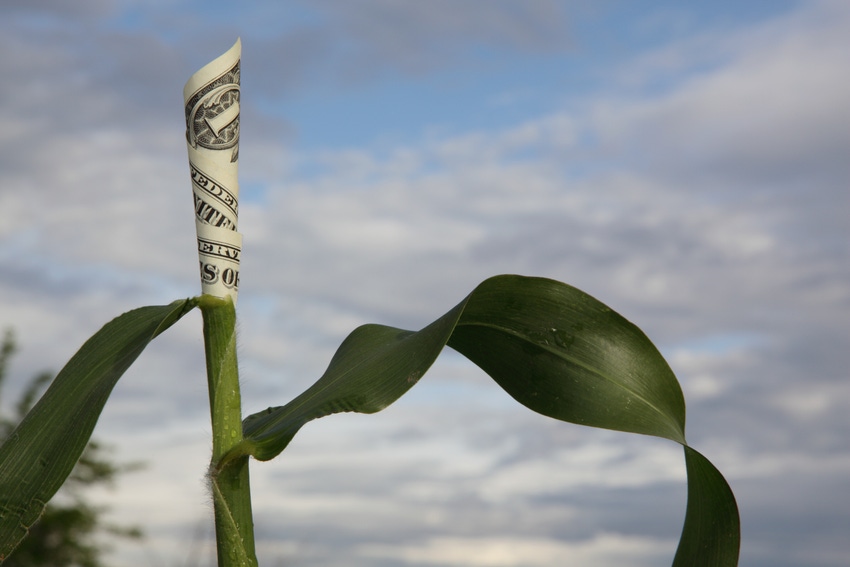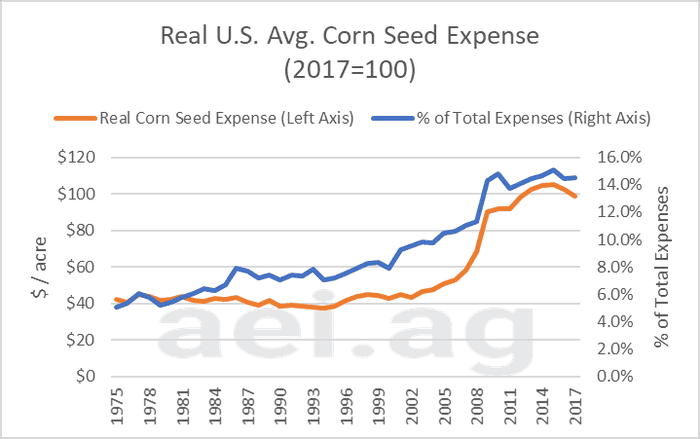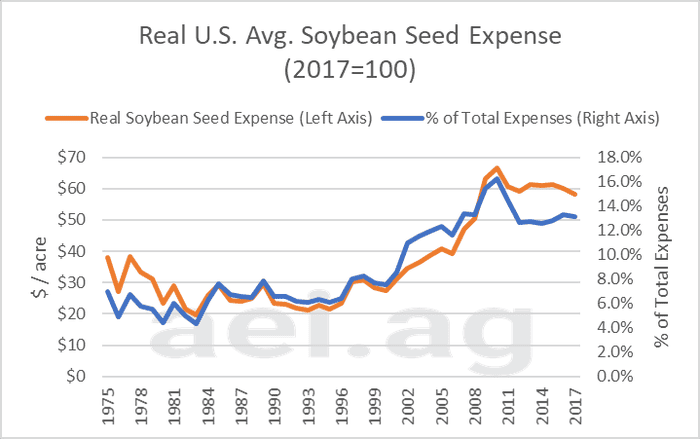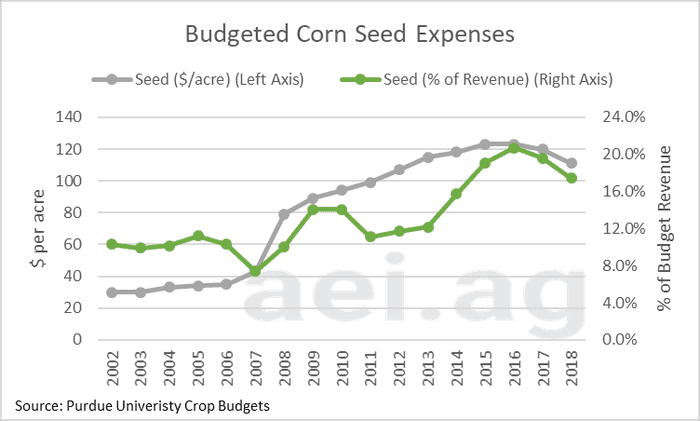October 24, 2018

Source: Agricultural Economic Insights
By David Widmar
Declining costs of production have been an important improvement during the farm economy downturn. While the overall trend has been for lower costs of production, changes in production expenses have not been uniform across inputs. Fertilizer, for example, has experienced significant declines. This week’s post reviews trends in corn and soybean seed expense.
National Trends: Corn Seed Expense
Figure 1 shows the USDA’s reported average annual corn seed expense. These data are shown since 1975 and are in real terms, or inflation-adjusted (2017 = 100). As we have noted in our earlier posts, the uptick in corn seed expense over the last decade has been nothing short of dramatic. Corn seed expense (shown in orange) was mostly $40 per acre from 1975 through the mid-2000s. In 2005, the expense began to increase, reaching a high of $105 per acre in 2015. Most recently, corn seed expense has turned lower in recent years. For 2017, corn seed expense was $99 per acre, a $6.25 per acre decline, or 6% lower, over two years.
Also shown in figure 1 is the share of total corn production expense that seed represented (in blue). Before 2000, seed expense was 8%, or less, of total corn production expenses. As seed expense increased, so did its share of total expenses. In 2015, corn seed reached a high of 15% of total expenses. By 2017, this share contracted to 14.5%. The shift from 8% of total corn production expenses to more than 14% tell us that, over time, seed expense has increased more than other expenses.
For context, corn seed expense increased from $43/acre in 2000 to $99 in 2017 (in real terms). Over the last 18 years, the expense increased by 131%, or increased at an average annual rate of 5.1%. That is a significant rate of increase sustained over nearly two decades.

Figure 1. Real U.S. Average Corn Seed Expenses, 1975 – 2017 (2017= 100). Data Source: USDA.
National Trends: Soybean Seed Expense
Figure 2 shows the national trend for soybean seed expense since 1975. Again, these data are inflation adjusted. Similar to corn, a significant increase in the per acre expense and share of total expenses occurred since the early 2000s. While soybean seed expense was previously around $25 per acre and 6% of total production expenses, in 2017 it accounted for $58 per acre and 13% of total expenses.
Real soybean seed expense peaked in the late 2000s at nearly $67 per acre (in 2017 dollars).
Comparing soybean expense in 2000 to 2017, the change over 18 years has been slightly less than corn. In total, seed expense increased by 113%, equal to a 4.5% average annual rate of change.

Figure 2. Real U.S. Average Soybean Seed Expenses, 1975 – 2017 (2017= 100). Data Source: USDA.
Purdue Crop Budgets
For a slightly different look at the trend in seed expense, Figure 3 shows corn seed expenses from Purdue University crop budgets. Specifically, the data show expense per acre (left axis) and the share of budgeted revenue (right axis).
Similar to the earlier data, corn seed expense in the crop budgets also turned higher during the farm economy boom. Where the budgets had been $30 per acre in the early 2000s, the expense exceeded $120 per acre recently.
In 2018, budgeted corn seed expense was $111 per acre. This represents a $12 per acre decline over two years, or a 10% decline. The decline is a welcome improvement for producers.
The additional good news is that corn seed expense has accounted for a declining share of budgeted revenue. In 2016 this reached a high of nearly 21%, but in 2018 declined to less than 18%. Even with the improvements, corn seed’s share of budgeted revenue remains above levels observed in the early 2000s.
Figure 3. Budgeted Corn Seed Expenses, Purdue University Crop Budgets. 2002 – 2017 (2017= 100). Data Source: USDA.
For soybean seed expense, Purdue crop budgets also reveal an improvement. Since 2017, budgeted soybean seed expense has reduced $7 per acre, or more than 9%. Similarly, seed expense has accounted for a declining share of budgeted revenue, falling from nearly 17% (2016) to less than 13% (2018).

Figure 4. Budgeted Soybean Seed Expenses, Purdue University Crop Budgets. 2002 – 2017 (2017= 100). Data Source: USDA.
Wrapping it Up
After initially resisting adjustments lower, seed expense for corn and soybean production have turned lower in recent years. Although the changes have been smaller than what was observed in fertilizer and cash rental rates, the improvement has been welcome. However, it is worth noting how much seed expenses increased during the farm economy boom. In most cases, seed still accounts for a historically high share of total production expenses (figures 1 and 2), or budgeted revenue (figures 3 and 4).
It is important to note these data are seed expense, which is a reflects several different factors. Undoubtedly, changes in seed prices have been an important contributor, but changes in seeding rates, which we looked at in an earlier post, have also had an impact.
Looking ahead, current commodity prices, especially for soybeans, will likely have producers carefully evaluating their budgets and plans for 2019. Seed may very well be an area of scrutiny, especially if producer believe viable alternatives exist- adjusting seeding rates, changing hybrids, or adjusting trait packages.
You May Also Like




